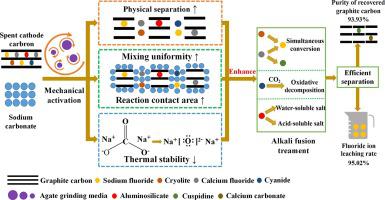当前位置:
X-MOL 学术
›
Miner. Eng.
›
论文详情
Our official English website, www.x-mol.net, welcomes your feedback! (Note: you will need to create a separate account there.)
Efficient separation of fluoride and graphite carbon in spent cathode carbon from aluminum electrolysis by mechanical activation assisted alkali fusion treatment
Minerals Engineering ( IF 4.8 ) Pub Date : 2021-01-01 , DOI: 10.1016/j.mineng.2020.106717 Zhen Yao , Qifan Zhong , Jin Xiao , Shengchao Ye , Lei Tang , Zhian Wang
Minerals Engineering ( IF 4.8 ) Pub Date : 2021-01-01 , DOI: 10.1016/j.mineng.2020.106717 Zhen Yao , Qifan Zhong , Jin Xiao , Shengchao Ye , Lei Tang , Zhian Wang

|
Abstract Spent cathode carbon (SCC) is the largest and most inevitable hazardous solid waste continuously discharged from the aluminum electrolysis industry. In this study, mechanical activation was used to assist alkali fusion treatment in dissociating toxic substances and recovering graphite carbon from SCC. The effect of mechanical activation (i.e., milling speed, ball-to-material mass ratio, and milling time) on the alkali fusion treatment was investigated. Its effect on the physicochemical properties of SCC–Na2CO3 mixtures was also analyzed through particle size distribution, Brunauer-Emmett-Teller surface area analysis, scanning electron microscopy, X–ray diffraction and thermogravimetric analysis–differential scanning calorimetry. Results showed that mechanical activation enhanced the alkali fusion treatment by improving the physical separation of fluoride, the mixing uniformity and reaction contact area of SCC and Na2CO3, and promoting the conversion of Na2CO3 to Na2O. The formation of agglomerates was the main reason that the carbon content of recovered graphite carbon and the fluoride ion leaching rate increased initially then decreased with the increment in mechanical activation conditions. Under optimal mechanical activation conditions, the carbon content of recovered graphite carbon and the fluoride ion leaching rate increased from 89.35% and 76.50% (non-activated sample) to 93.93% and 95.02%, respectively, indicating that mechanical activation assisted alkali fusion treatment effectively enhanced the separation efficiency of fluoride and graphite carbon. In addition, thermodynamic analysis of the alkali fusion treatment and characterization of recovered graphite carbon (under the optimal mechanical activation conditions) were performed. Results demonstrated that the simultaneous conversion of multiple fluorides (i.e., Na3AlF6 and CaF2) and oxidative decomposition of cyanide in SCC can be achieved via mechanical activation assisted alkali fusion treatment. These findings indicate that mechanical activation–assisted alkali fusion treatment is a promising method for the detoxification and utilization of SCC.
中文翻译:

通过机械活化辅助碱熔处理有效分离铝电解废阴极碳中的氟化物和石墨碳
摘要 废阴极碳(SCC)是铝电解行业持续排放的最大、最不可避免的危险固体废物。在这项研究中,机械活化用于辅助碱熔处理解离有毒物质和从 SCC 中回收石墨碳。研究了机械活化(即研磨速度、球与材料的质量比和研磨时间)对碱熔处理的影响。还通过粒度分布、Brunauer-Emmett-Teller 表面积分析、扫描电子显微镜、X 射线衍射和热重分析-差示扫描量热法分析了其对 SCC-Na2CO3 混合物理化性质的影响。结果表明,机械活化通过改善氟化物的物理分离、SCC与Na2CO3的混合均匀性和反应接触面积,促进Na2CO3向Na2O的转化,增强了碱熔处理。团聚体的形成是回收石墨碳的含碳量和氟离子浸出率随机械活化条件的增加先增加后降低的主要原因。在最佳机械活化条件下,回收石墨碳的含碳量和氟离子浸出率分别从89.35%和76.50%(未活化样品)提高到93.93%和95.02%,表明机械活化有效辅助碱熔处理提高了氟化物和石墨碳的分离效率。此外,进行了碱熔处理的热力学分析和回收石墨碳的表征(在最佳机械活化条件下)。结果表明,通过机械活化辅助碱熔处理,可以实现 SCC 中多种氟化物(即 Na3AlF6 和 CaF2)的同时转化和氰化物的氧化分解。这些发现表明机械活化辅助碱融合处理是一种很有前景的 SCC 解毒和利用方法。Na3AlF6 和 CaF2) 和 SCC 中氰化物的氧化分解可以通过机械活化辅助碱熔处理来实现。这些发现表明机械活化辅助碱融合处理是一种很有前景的 SCC 解毒和利用方法。Na3AlF6 和 CaF2) 和 SCC 中氰化物的氧化分解可以通过机械活化辅助碱熔处理来实现。这些发现表明机械活化辅助碱融合处理是一种很有前景的 SCC 解毒和利用方法。
更新日期:2021-01-01
中文翻译:

通过机械活化辅助碱熔处理有效分离铝电解废阴极碳中的氟化物和石墨碳
摘要 废阴极碳(SCC)是铝电解行业持续排放的最大、最不可避免的危险固体废物。在这项研究中,机械活化用于辅助碱熔处理解离有毒物质和从 SCC 中回收石墨碳。研究了机械活化(即研磨速度、球与材料的质量比和研磨时间)对碱熔处理的影响。还通过粒度分布、Brunauer-Emmett-Teller 表面积分析、扫描电子显微镜、X 射线衍射和热重分析-差示扫描量热法分析了其对 SCC-Na2CO3 混合物理化性质的影响。结果表明,机械活化通过改善氟化物的物理分离、SCC与Na2CO3的混合均匀性和反应接触面积,促进Na2CO3向Na2O的转化,增强了碱熔处理。团聚体的形成是回收石墨碳的含碳量和氟离子浸出率随机械活化条件的增加先增加后降低的主要原因。在最佳机械活化条件下,回收石墨碳的含碳量和氟离子浸出率分别从89.35%和76.50%(未活化样品)提高到93.93%和95.02%,表明机械活化有效辅助碱熔处理提高了氟化物和石墨碳的分离效率。此外,进行了碱熔处理的热力学分析和回收石墨碳的表征(在最佳机械活化条件下)。结果表明,通过机械活化辅助碱熔处理,可以实现 SCC 中多种氟化物(即 Na3AlF6 和 CaF2)的同时转化和氰化物的氧化分解。这些发现表明机械活化辅助碱融合处理是一种很有前景的 SCC 解毒和利用方法。Na3AlF6 和 CaF2) 和 SCC 中氰化物的氧化分解可以通过机械活化辅助碱熔处理来实现。这些发现表明机械活化辅助碱融合处理是一种很有前景的 SCC 解毒和利用方法。Na3AlF6 和 CaF2) 和 SCC 中氰化物的氧化分解可以通过机械活化辅助碱熔处理来实现。这些发现表明机械活化辅助碱融合处理是一种很有前景的 SCC 解毒和利用方法。


























 京公网安备 11010802027423号
京公网安备 11010802027423号